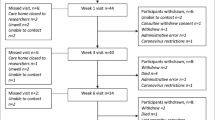Abstract
This study evaluated various functional capacity measures in two cohorts of patients participating in a functional restoration program: 1) subacute patients (defined as being admitted to the program within 1/2 year of injury), and 2) chronic patients (defined as being admitted after 1/2 year of injury). The main aim was to evaluate the differential effects of subacute versus chronic intervention functional outcomes of low back pain patients who participated in a functional restoration program. Findings clearly demonstrated that, compared to the chronic intervention group (n = 170), the subacute intervention group (n = 110) displayed greater functional performance gains in various tasks (e.g., range of motion, lifting capacity, etc.). These findings are consistent with recent suggestions in the literature that early intervention will produce greater therapeutic improvement in low back pain patients, with resultant health-care cost savings. Additional research is needed to further evaluate the utility of distinguishing among acute, subacute, and chronic patients as a means of predicting the degree of functional gains produced by intervention.
Similar content being viewed by others
REFERENCES
Mayer TG, et al. A prospective randomized two year study of functional restoration in industrial low back injury utilizing objective assessment. J Am Med Assoc 1987; 258: 1763–1769.
Mayer TG, et al. Objective assessment of spine function following industrial injury: A prospective study with comparison group and one-year follow-up. Spine 1985; 10: 482–493.
Mayer TG, Gatchel RJ. Functional restoration for spinal disorders: The sports medicine approach. Philadelphia: Lea & Febiger, 1988.
Bendix AE, et al. Multidisciplinary intensive treatment for chronic low back pain: A randomized, prospective study. Cleveland Clin J Med 1996; 63: 62–69.
Hazard RG, et al. Functional restoration with behavioral support: A one-year prospective study of patients with chronic low-back pain. Spine 1989; 14: 157–161.
Linton SJ, Bradley LA. Strategies for the prevention of chronic pain. In: Gatchel RJ, Turk DC, eds. Psychological approaches to pain management: A practitioner's handbook. New York: Guilford Publications, 1996.
Linton SJ, Bradley LA. An 18-month follow-up of a secondary prevention program for back pain: Help and hindrance factors related to outcome maintenance. Clin J Pain 1992; 8: 227–236.
Mitchell RI, Carmen GM. Results of a multicenter trial using an intensive active exercise program for the treatment of acute soft tissue and back injuries. Spine 1990; 15: 514–521.
Jordan KD, Mayer TG, Gatchel RJ. Should disability chronicity be an exclusion criterion for tertiary rehabilitation? Socioeconomic outcomes of early vs. late functional restoration in compensation spinal disorders. Spine 1998; 23: 2110–2116.
Bigos SJ, et al. Acute low back problems in adults: Assessment and treatment. Quick reference to guide clinicians. No. 14, Washington: U.S. Department of Health and Human Services, Agency for Health Care Policy Research (AHCPR), 1994.
Committee A.A.T.N.H., New Zealand acute low back guide. Wellington, New Zealand, 1997.
Mayer TG, et al. Contemporary concepts in spine care rehabilitation: Secondary and tertiary nonoperative care. Spine 1995; 20: 2060–2066.
Keeley J, et al. Quantification of lumbar function, Part V: Reliability of range of motion measures in the sagittal plane and an in vivo torso rotation measurement technique. Spine 1986; 11: 31–35.
Mayer TG, et al. Progressive isoinertial lifting evaluation: An erratum. Spine 1990; 15: 5.
Mayer TG, et al. Progressive isoinertial lifting evaluation. Part I. A standardized protocol and normative database. Spine 1988; 13: 993–997.
Fishbain DA, et al. Measuring residual functional capacity in chronic low back pain patients based on the dictionary of occupational titles. Spine 1994; 19: 872–880.
Ebbeling C, et al. Development of a single-stage submaximal treadmill walking test. Med & Sci Sports & Exerc 1991; 23(8): 966–973.
Author information
Authors and Affiliations
Rights and permissions
About this article
Cite this article
Woods, C.S., Kishino, N.D., Haider, T.T. et al. Effects of Subacute Versus Chronic Status of Low Back Pain Patients' Response to a Functional Restoration Program. J Occup Rehabil 10, 229–233 (2000). https://doi.org/10.1023/A:1026618519877
Issue Date:
DOI: https://doi.org/10.1023/A:1026618519877




